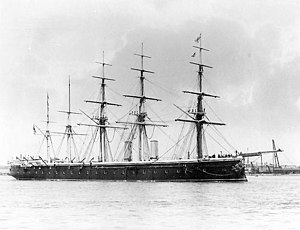 Minotaur at anchor
| |
| History | |
|---|---|
| Name | HMS Minotaur |
| Namesake | Minotaur |
| Ordered | 2 September 1861 |
| Builder | Thames Ironworks and Shipbuilding Company |
| Laid down | 12 September 1861 |
| Launched | 12 December 1863 |
| Completed | 1 June 1867 |
| Commissioned | April 1867 |
| Fate | Sold for scrap, 1922 |
| General characteristics (as completed) | |
| Class and type | Minotaur-class armoured frigate |
| Displacement | 10,627 long tons (10,798 t) |
| Length |
|
| Beam | 59 ft 6 in (18.1 m) |
| Draught | 27 ft 9 in (8.5 m) |
| Installed power | 6,949 ihp (5,182 kW) |
| Propulsion |
|
| Sail plan | 5-masted |
| Speed | 14 knots (26 km/h; 16 mph) |
| Range | 1,500 nmi (2,800 km; 1,700 mi) at 7.5 kn (13.9 km/h; 8.6 mph) |
| Complement | 800 actual |
| Armament | |
| Armour | |
HMS Minotaur was the lead ship of the Minotaur-class armoured frigates built for the Royal Navy during the 1860s. Minotaur took nearly four years between her launching and commissioning because she was used for evaluations of her armament and different sailing rigs.
The ship spent the bulk of her active career as flagship of the Channel Squadron, including during Queen Victoria's Golden Jubilee Fleet Review in 1887. She became a training ship in 1893 and was then hulked in 1905 when she became part of the training school at Harwich. Minotaur was renamed several times before being sold for scrap in 1922 and broken up the following year.